

The Ancient era had gotten this game off to a great start (pun intended) as I ruthlessly exploited the bugs associated with the Great Wall to build them everywhere across my territory. Next it was time to proceed onwards into the Exploration age where I could continue doing the same thing:
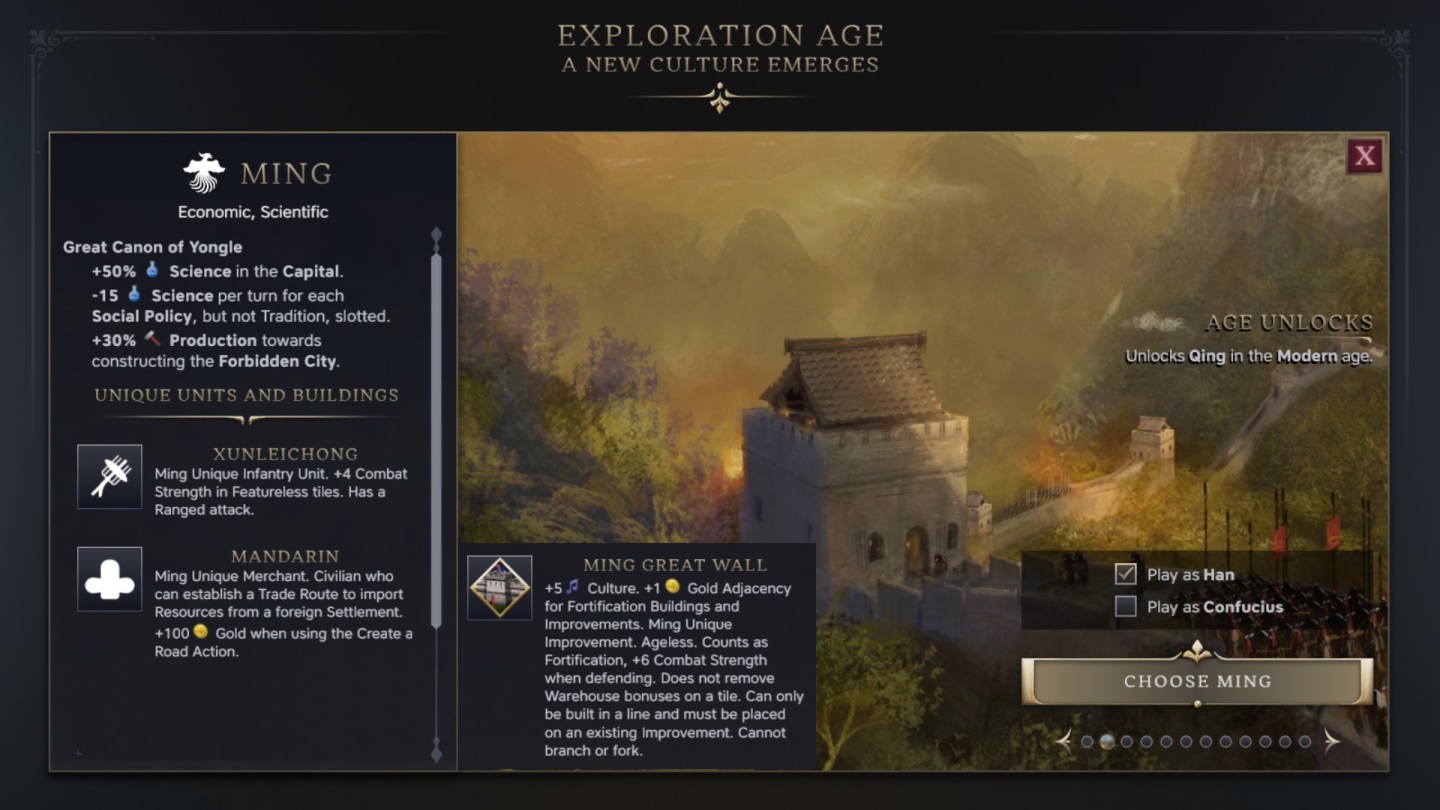
I had no choice on which civ to pick if I wanted to keep throwing down more Great Walls, it had to be Ming China. The Xunleichong and Mandarin unique units were unimportant for this variant, I was only interested in the Ming Great Wall unique tile improvement. This was similar to the Han Great Wall from the previous era, however the base culture was higher (5 culture as opposed to 2 culture) and the adjacency bonus had shifted from happiness to gold. That was an improvement since I wasn't having much trouble keeping my various settlements happy and I could always find more uses for gold. In fact, since I was retaining the same two mementoes from the previous era for +1 settlement cap and the same +1 culture/gold on unique buildings, there was the potential to stack up some truly impressive yields on those wall segments. Along with Achaemenid Xerxes also getting +1 culture/gold per age on unique buildings, which would tick up here in the second era, I could easily be seeing 8 culture and 5 gold per Great Wall! Let's build them everywhere and see if the Deity AIs could keep up.
For the legacy scoring points, the most important choice to take was Fealty in the Military category which adds +2 to the settlement limit. As I've written elsewhere, I view this legacy option as essentially mandatory to take for anything resembling a serious game, and it's tiresome how the player has to fulfill the requirements for this one and the Economic Golden Age option over and over again or else suffer big penalties. Speaking of that Economic category, I had the option to spend two of my three legacy points on the Silk Road Golden Age or else spend them on the Master Caravaneer bonus which would grant 5 gold per trade route from the previous era (25 gold/turn in total). Taking the Silk Road Golden Age did basically nothing here since I only had two cities and could even switch my capital to maintain those two cities. However, I don't like my cities becoming towns again and took the Silk Road Golden Age anyway as a point of pride; my self-respect was worth more than 25 gold/turn which would quickly become meaningless under this variant.
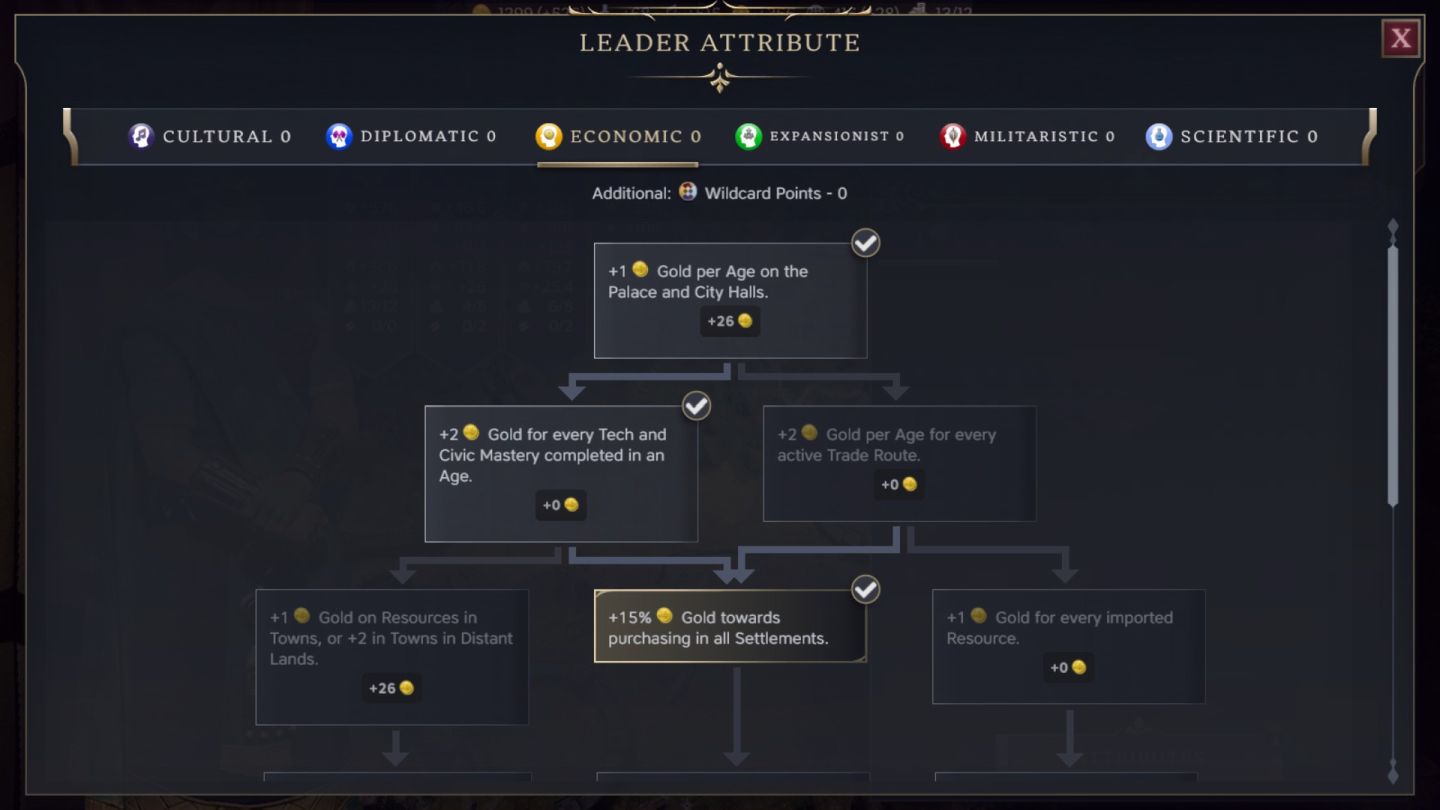
I also had the usual handful of attribute points to spend, if not as many as in my non-variant games since I didn't qualify for anything in the Science category. There were two attribute points that mattered here, starting with a point in the Diplomatic tree granting +50% influence towards befriending independent powers. While I wouldn't be able to double up this ability with the unique Xenia policy from the Greek civics tree as in my Machiavelli game, this would still make it significantly easier to convert those independent powers into city state friends. Then the other key attribute point was the pictured +15% gold towards purchases in all settlements from the Economic tree. Needless to say, I planned to do a lot of rush-buying in my towns and this would make everything cheaper, forever. It was an obvious must-have.
Once I finised assigning the various legacy points, I passed through the era transition and the Exploration age was underway. I started out by scanning through my settlements and, wait, what the heck was going on here?
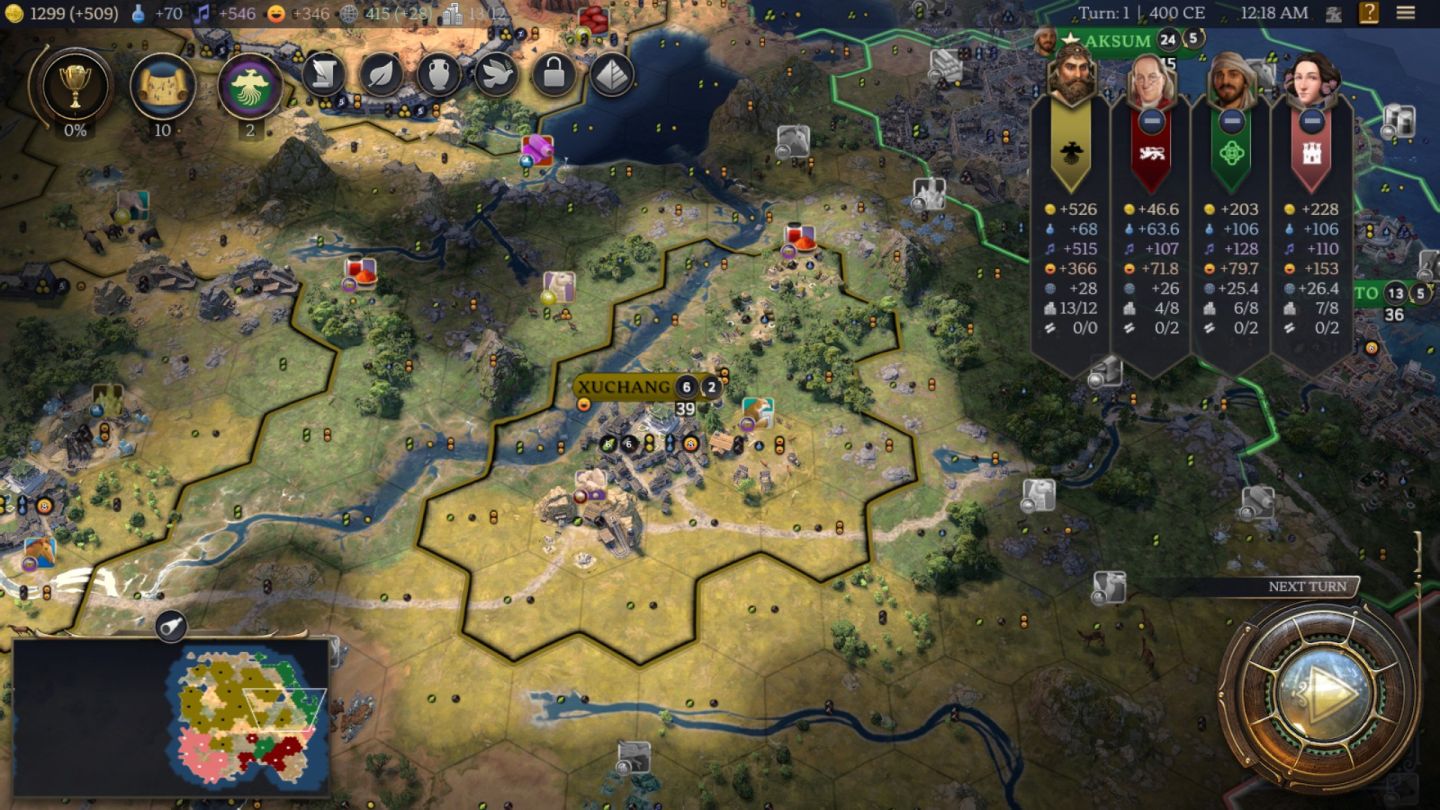
Xuchang was one of the two towns that I had dropped on the final turn of the Ancient era to hit the tier 3 Military scoring goal. It had started out at size 3 due to the Han unique ability; normally towns start at size 2 and the Han get that extra population point for free. And yet, somehow, after the era transition this town was now size 6?!? What in the world???  And Xuchang wasn't unique in that respect, I found that a number of my towns had added a population point or two, somehow, during the era transition. This was utterly baffling but here's my best guess as to what had happened. On that last turn of the Ancient era, I had grown Xuchang to the two tiles northeast of the central tile, not purchasing Han Great Walls on them because I planned to put Ming Great Walls atop them in the next era. Apparently the game had decided that it wanted me to connect the three nearby resources, the spices and furs and nitre, so therefore Civ7 grew Xuchang to size 6 during the era transition and connected those three resources.
And Xuchang wasn't unique in that respect, I found that a number of my towns had added a population point or two, somehow, during the era transition. This was utterly baffling but here's my best guess as to what had happened. On that last turn of the Ancient era, I had grown Xuchang to the two tiles northeast of the central tile, not purchasing Han Great Walls on them because I planned to put Ming Great Walls atop them in the next era. Apparently the game had decided that it wanted me to connect the three nearby resources, the spices and furs and nitre, so therefore Civ7 grew Xuchang to size 6 during the era transition and connected those three resources.
Let me be clear: I did *NOT* want Xuchang to grow to size 6! Every additional size for the town meant a larger food box to fill up, and being size 6 instead of size 3 meant needing about 350 food per growth instead of 135 food per growth. I had specifically gone to the northeast at Xuchang because it would lead to a superior Great Wall shape in the long run, at the tradeoff of adding woodcutters that provided no food. This wouldn't matter with a small food box but absolutely did matter at the larger food box that Xuchang was now facing. So this new settlement was basically screwed and would barely grow at all throughout the whole Exploration age, crippled by this utterly inexplicable mechanic that grew my cities and added tile improvements without asking me. Further north at Chendgu, the settlement went from size 6 to size 9 and actually grabbed three non-resource woodcutters, because apparently Civ7 just decided that I had to have those tiles for some reason? Then I was going to go back and load an autosave from the final turn of the Ancient era to experiment with this mechanic, only to find that all of my autosaves from the Ancient era were now gone! Civ7 decided that I didn't need them anymore since I had advanced to the Exploration age and removed them.
What the F*** was going on here?!?  It's no wonder people hate Civ7 so much, these era transitions are appalling. The fact that the game literally GREW MY TOWNS AND IMPROVED RANDOM TILES without asking me is completely bonkers. This wasn't bad enough to get me to rage quit the game again, but holy cow, I don't think I've seen anything like this since the infamous Master of Orion 3. That game would build DEAs and train ships without asking the player too; at least Civ7 is a lot prettier to look at. (One more note: I eventually discovered after digging around at CivFanatics that those autosaves from the previous era do still exist, only hidden away in a subfolder that the player has to dig out manually from their hard drive. Why in the world did the developers take the time to program hiding the player's autosaves when there were so many other crippling omissions at the time of release?!)
It's no wonder people hate Civ7 so much, these era transitions are appalling. The fact that the game literally GREW MY TOWNS AND IMPROVED RANDOM TILES without asking me is completely bonkers. This wasn't bad enough to get me to rage quit the game again, but holy cow, I don't think I've seen anything like this since the infamous Master of Orion 3. That game would build DEAs and train ships without asking the player too; at least Civ7 is a lot prettier to look at. (One more note: I eventually discovered after digging around at CivFanatics that those autosaves from the previous era do still exist, only hidden away in a subfolder that the player has to dig out manually from their hard drive. Why in the world did the developers take the time to program hiding the player's autosaves when there were so many other crippling omissions at the time of release?!)
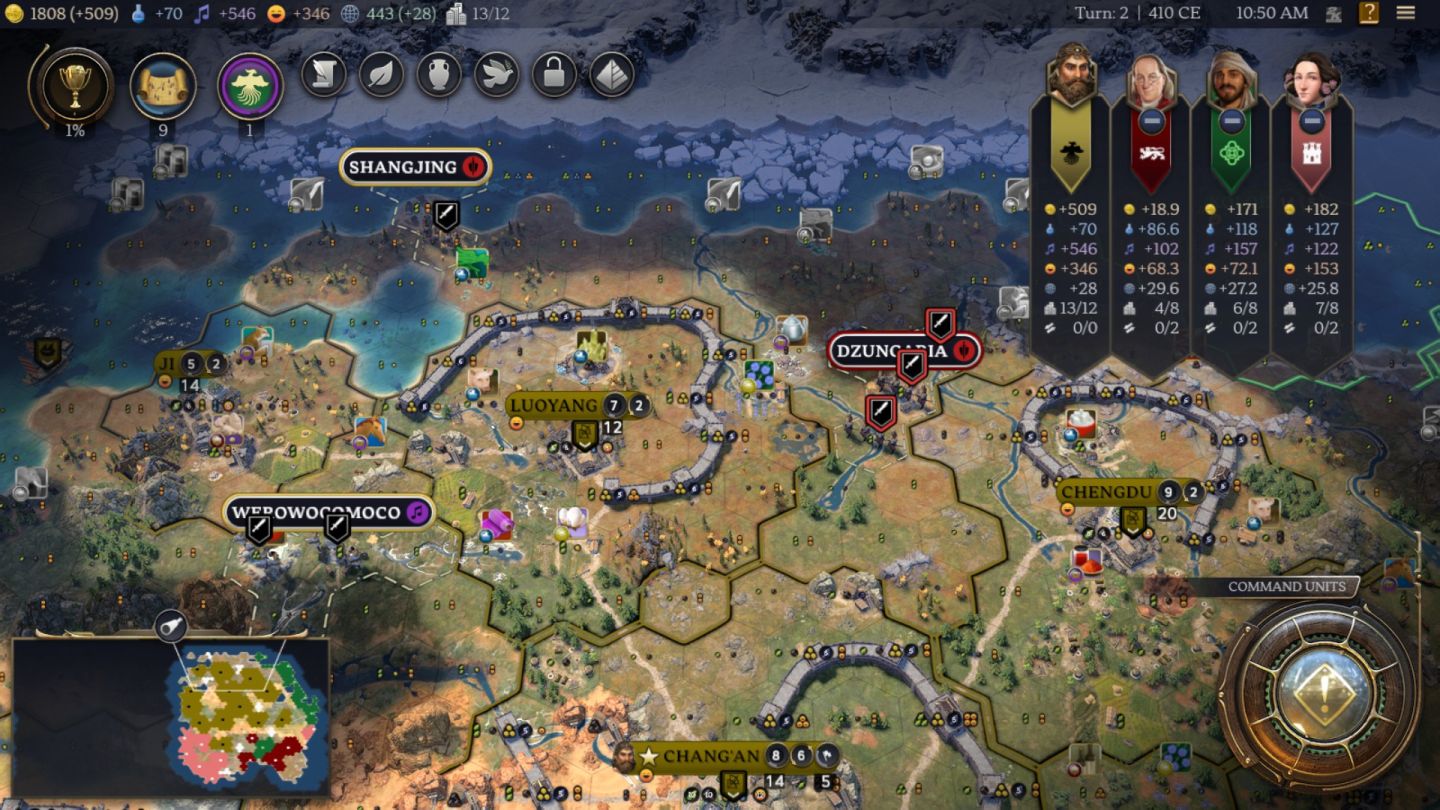
Unfortunately the bad news didn't end there. I had carried over 400 influence from the previous era and explored every inch of the starting continent, ready to pounce on the independent powers when they spawned out of thin air on Turn 2. I was looking specifically for the Scientific and Economic city states as they had the bonus powers that I most wanted, very useful unique tile improvements that I wanted to unlock along with extra beakers and extra money and free techs. However, to my dismay I surveyed the map and found that there were no independent powers of either type to be found! There were seven IPs on the starting continent and all seven of them rolled as either Military or Cultural. This was almost absurdly unlikely since the odds to get either Scientific or Economic on the typing is 50%; failing seven such coin flips in a row comes out at under 1% odds. The Military and Cultural independent powers didn't have much of anything that I wanted because I wouldn't be fighting anyone and I would already be drowning in more culture than I knew what to do with. This was a rough blow and there was nothing to be done other than get over to the other continent ASAP and try to find the remaining IPs.
On that note, it was time to begin the gimmick of this era by sending out ships to explore the rest of the map. Except that I had a problem here: I couldn't produce ships of any kind! It turns out that Civ7 requires a Fishing Quay or other related urban building placed on the water to be able to train ships. You would think that if a settlement sits directly on the coast it would be able to rush-buy ships, but nope, in contradiction of every other Civilization game, Civ7 requires a water-based urban district. Thus I would get exactly one ship ever, the starting cog, and that would be it. No more ships for me. I made up for this by cash-rushing scouts in all of my settlements, close to a dozen of them in total, and sending them out in every direction. I had to research Cartography tech to allow non-military units to cross ocean tiles which was already underway at the best speed my science-challenged empire could manage. Hopefully it would take half a dozen turns to knock that tech out and then my scout brigade would be off.
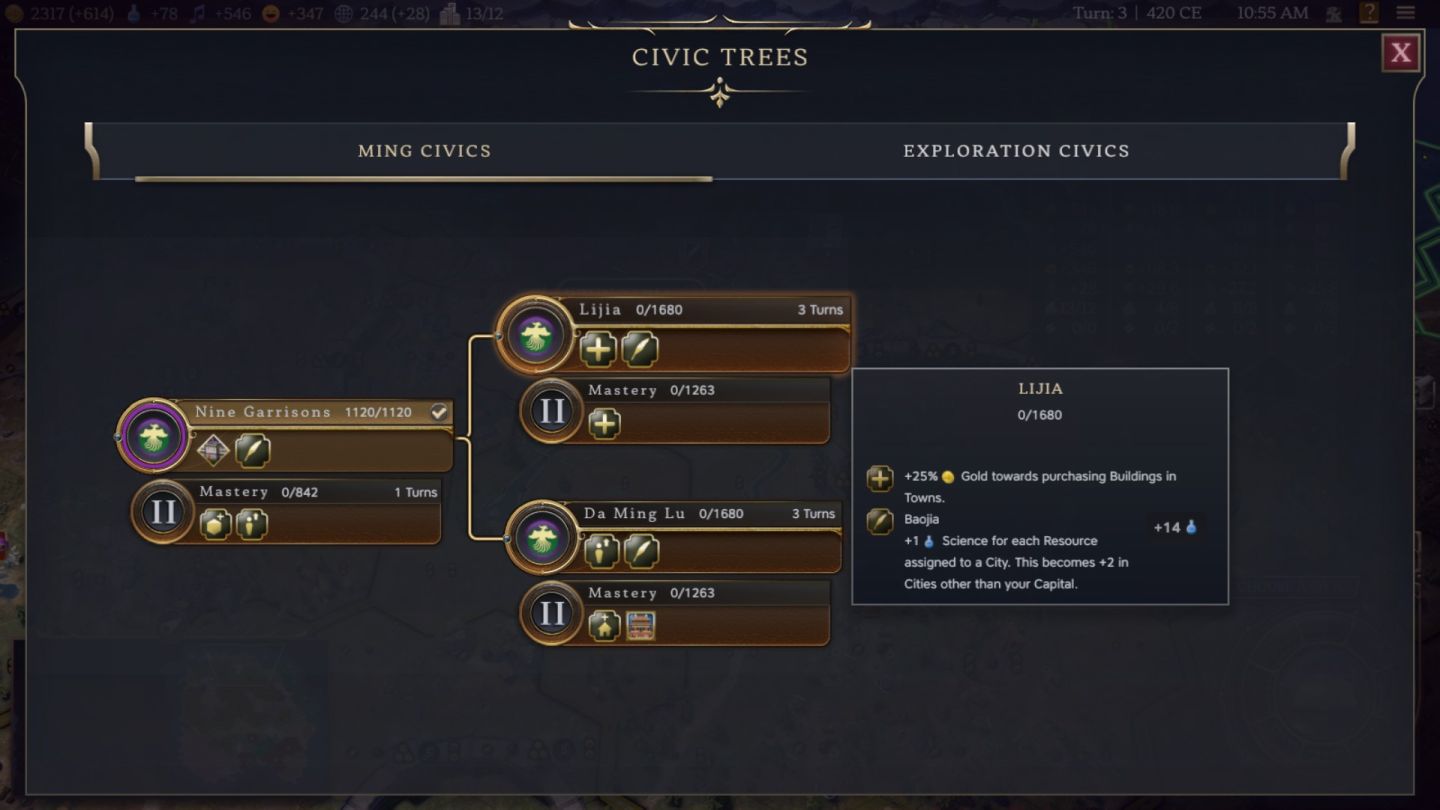
Normally the player has to start the Exploration age by researching the Piety civic since that's the one that founds a religion and any delay in doing so will see all of the best religious options get taken. This wasn't an issue for me though: founding a religion in Civ7 requires researching Piety and then building a temple, something that I could never do under these restrictions. Thus I would never have a religion either which was a real shame because I could have spammed missionaries with ease later on. Instead, I opened up the era by diving into the Ming unique civics tree which had some very useful perks to unlock. First was the Ming Great Wall at the initial Nine Garrisons civic which took all of two turns and granted me instant access to the bugged tile improvement. Next I continued onwards to Lijia which had the ridiculous +25% gold towards purchasing buildings in towns ability, something that would provide a massive discount on every Great Wall for the rest of the age.
Together with my +15% gold towards all purchases Economic attribute point plus the various gold resources scattered across the map, I was going to have cheap, cheap, cheap unique tile improvements to splash in my towns. The base production cost for the Ming Great Wall is 90 shields which translates into 360 gold under Civ7's 1:4 conversion ratio. However, once I had Lijia unlocked and combined it with those other purchase discounts, the cost per Great Wall was already down to 192 gold. That was basically the same as the old Han Great Wall and my income was already higher, starting at 500 gold/turn at the outset and quickly climbing. From this point forward, the limitation on the number of Great Wall segments I could create was town population growth, not money.
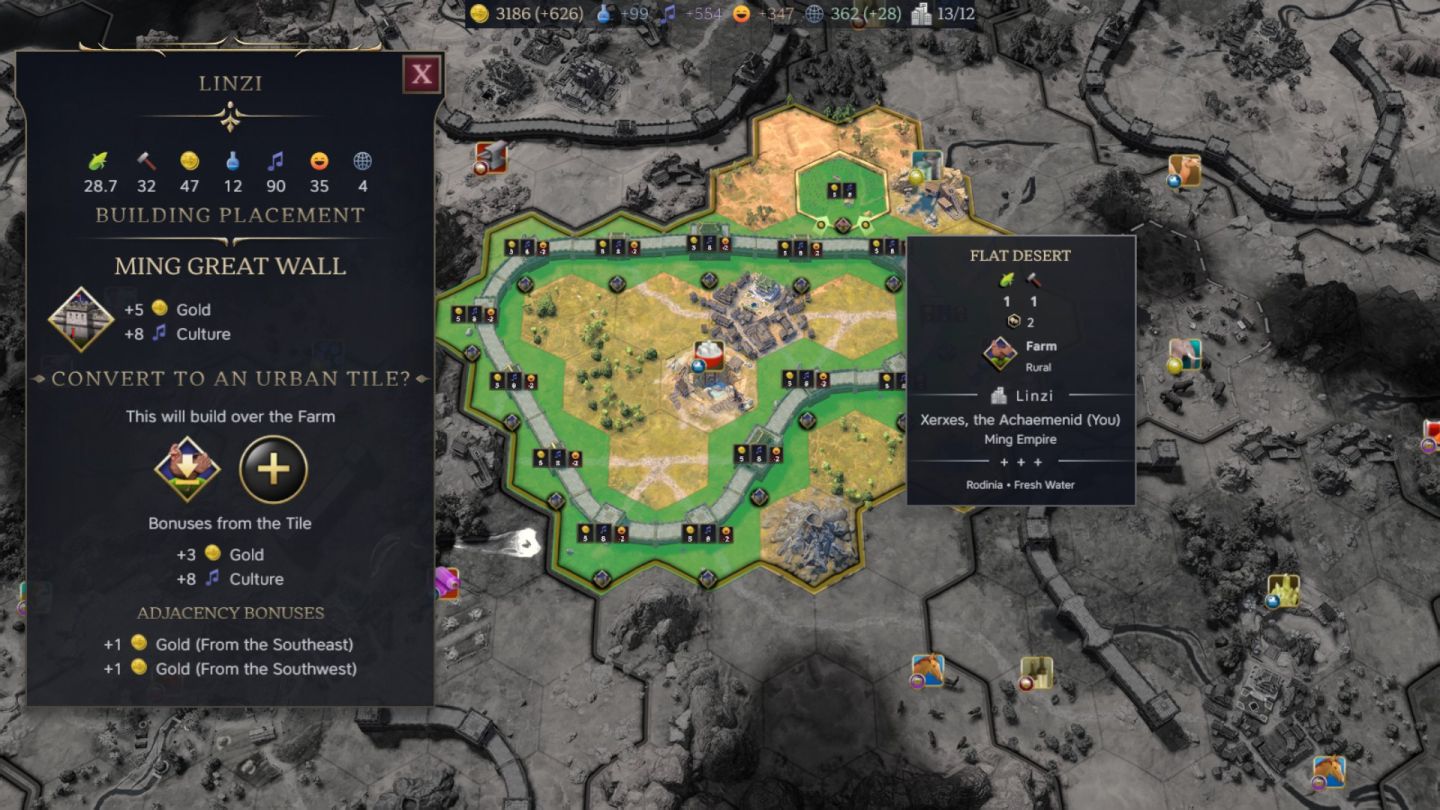
One of the questions that I had going into this era was how the older Han Great Walls would interact with the new Ming walls. Would they follow all of the same rules or would it be some kind of weird hybrid system? Given that this was Civ7, I shouldn't have been surprised that the answer was option B, weird hybrid system. In the screenshot above, Linzi was able to place a Ming Great Wall on the highlighted tile which was obviously an illegal spot in relationship to the previously placed Han Great Wall. What was going on here? After I did some more experimenting I was able to figure out the system: the Ming Great Walls simply ignored the Han Great Walls completely. The new walls treated all of the tiles with the old walls as if they were a normal rural tile; I could build the newer walls on top of any of the old walls, or build right next to them to have dual walls snaking across the landscape together. This was highly convenient and created lots of flexibility as far as how I wanted to develop my settlements. The basic rule was that I'd replace a Han Great Wall with a Ming Great Wall if possible, but it was better to have more total wall segments of either type as opposed to rural tiles lacking walls altogether. This would lead to some truly ridiculous screenshots later as I had fun playing in my walled sandbox.
There was also the question of what happened when a Ming Great Wall segment replaced a Han Great Wall. I tested and found that this did *NOT* decrease the population of the settlement in question; only adding a Ming Great Wall to a new rural tile would have the same -1 population effect. This didn't end up having much of an effect in practice, only keeping things from getting even more abusive when I replaced the older wall segments with the newer ones at my original towns.
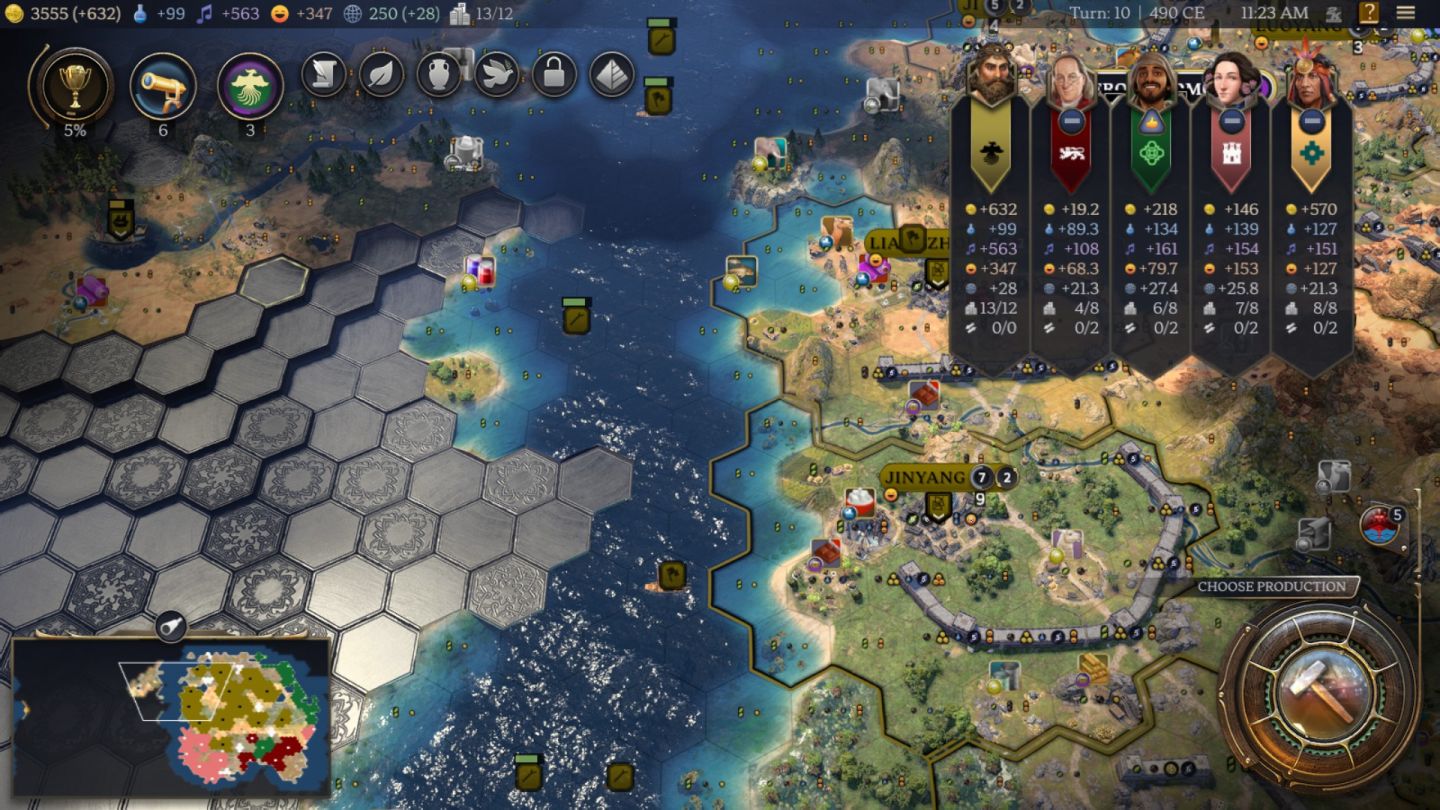
Cartography tech arrived on Turn 8 and my scout flotilla splashed into the waters off the coastlines. I had several scouts heading eastwards after spending influence to get an Open Borders deal with Ibn Battuta but the bulk of them were over here in the west. My single cog had spawned over here and made the crossing immediately, finding an empty portion of the distant lands continent along with meeting Pachacuti of the Incas. His cities were located on the western edge of that continent which meant that the eastern side was open for the taking. I already had three settlers in the water making the ocean crossing and I was purchasing more of them as fast as my income would allow. These units were all completely undefended since I was far away from reaching the tech that allows military units to traverse ocean tiles. I figured that the scouts could screen for the settlers following in their wake, and if I did lose a settler, well, I could always purchase more of them.
As far as the other AI leaders were concerned, I was already far ahead of them and they were becoming more irrelevant by the turn. I was already producing as much culture as the rest of the world combined and newcomer Pachacuti was the only leader who was comparable in terms of income. What was truly shocking to me was my science output, which was roughly equivalent to the other leaders despite not having a single science building or science-producing tile improvement. Again, this was Deity difficulty, as high as Civ7 goes. How pathetic was their city-building if they couldn't even outpace someone who wasn't constructing any urban buildings?! At least I was able to get a new Farmer's Market endeavor from Ibn Battuta for 6 food/turn in every town, that would only help my town-based snowball accelerate that much faster.
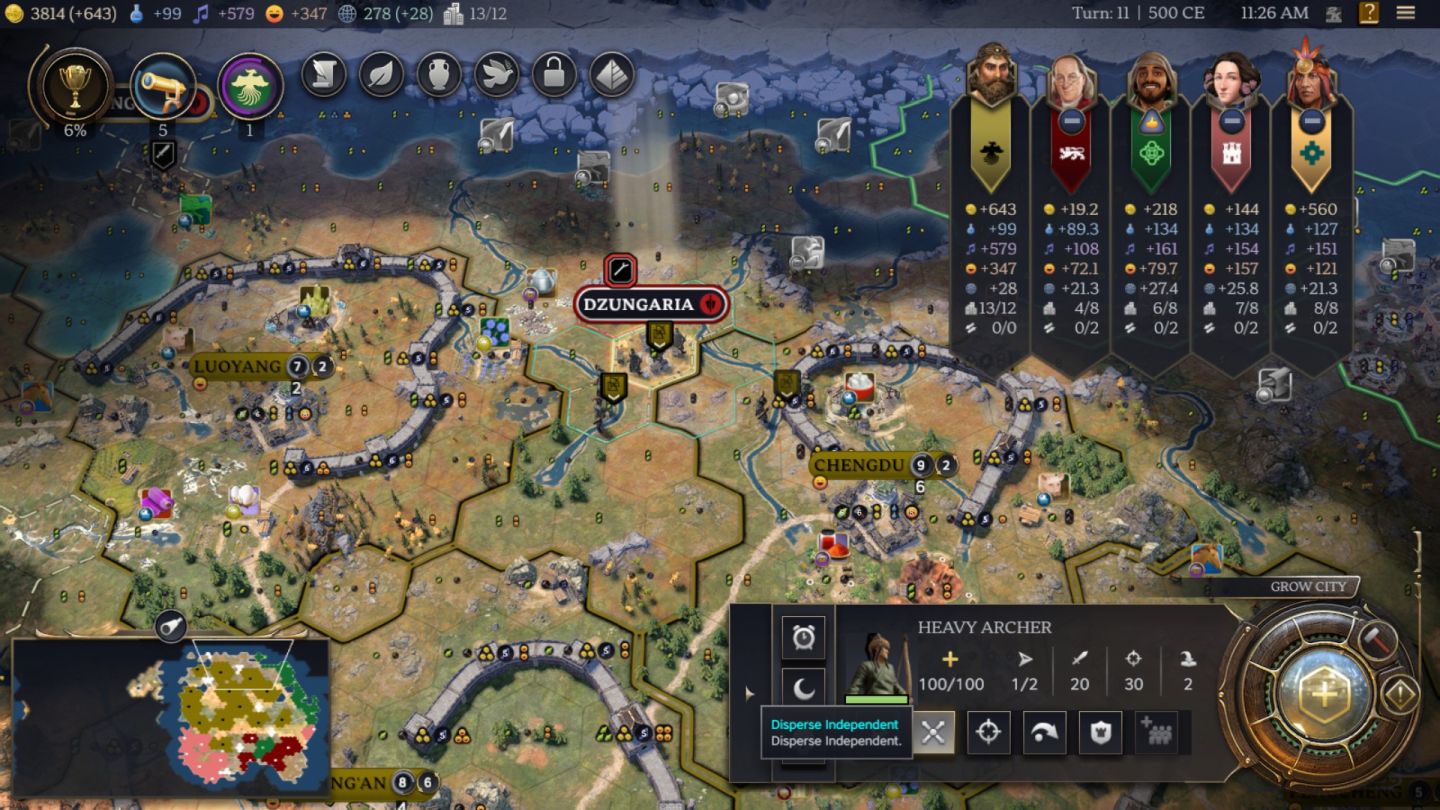
I didn't need access to three different Military independent powers and used the heavy archers that carried over from the previous era to raze the pictured Dzungaria. This opened up enough space for me to plant a settlement in the northern tundra, the only one that I would add on the home continent in this era. I almost didn't place a town here because I wasn't sure that I wanted to use up a limited settlement slot in the extreme north, then ended up being glad that I did since this spot grew like a weed. The general rule in Civ7 seems to be that pretty much any spot is worth settling, with places that have resources being better but even blank normal terrain working well too. This is one of the biggest weaknesses in the gameplay as far as I'm concerned: with grassland being no better than tundra or desert, everything feels the same and there's no incentive to struggle for control of the fertile parts of the map. So while it's cool that the player can build these massive tundra metropolises, it's hard to avoid the feeling that Civ4's stark division between high-food and low-food terrain made for a much better mechanic.
I met the final AI opponent a few turns later who ended up being Lafayette. He was playing as the Hawaiians in this era and had his core in the southeast corner of the distant lands continent, just to the west of Ada Lovelace across the dividing waters. Lafayette's culture was decent but otherwise he looked pretty weak from what I could tell. The AI leaders on my continent seemed to make no effort to colonize overseas, instead falling back into their endless squabbling once again. Franklin started a new war with Ibn Battuta to recapture one of the cities that he had given away in a previous conflict and that tied up the two of them for the next few dozen turns. I've been getting less and less scared of these clowns with every game I play; once the player gets a fair start under the "Balanced" map setting, it's pretty easy to pacify the AI leaders diplomatically and then let them self-destruct against each other. While I think they're still better than the completely hopeless Civ6 AIs, their performance remains terrible.
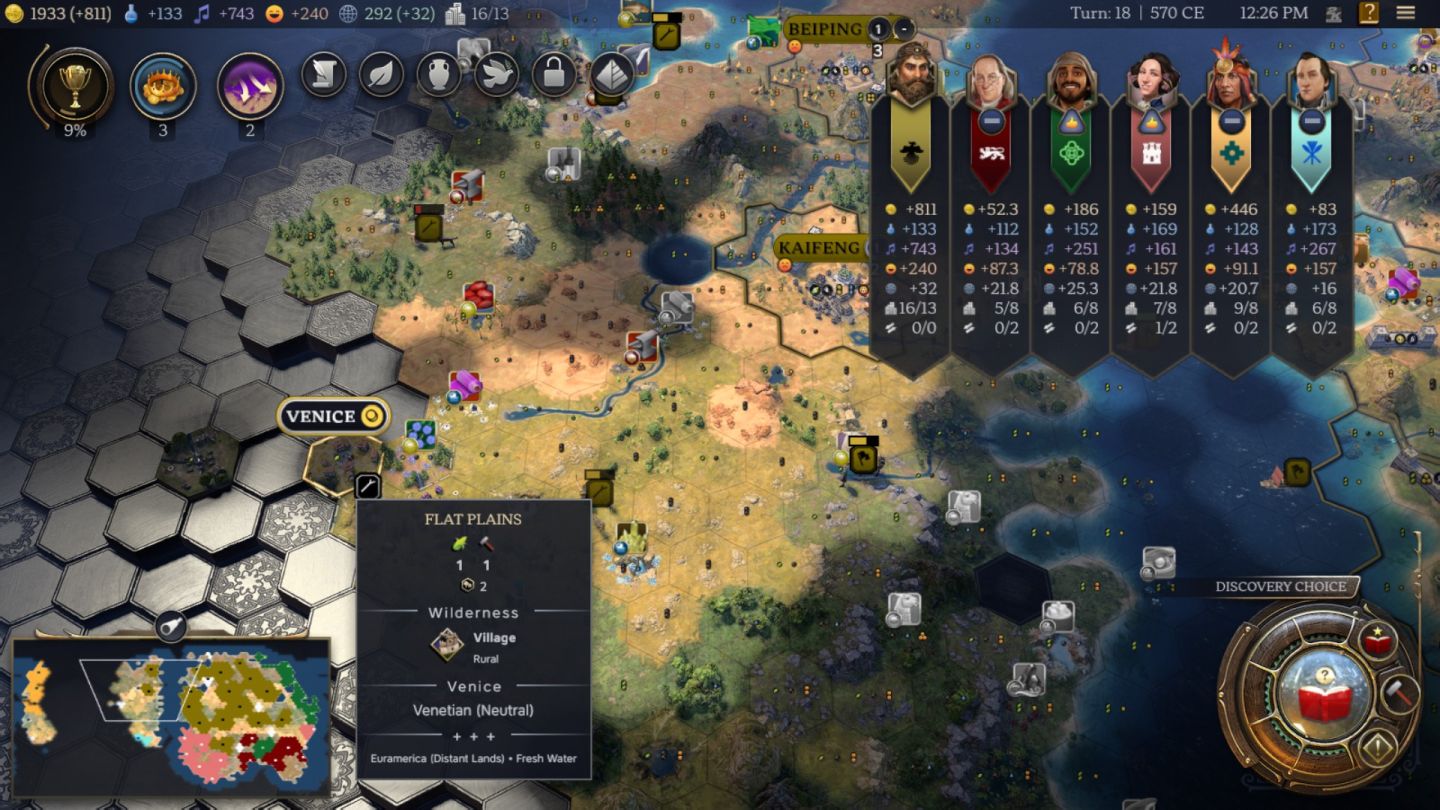
By the time of this screenshot on Turn 18, I had already established my first two distant lands settlements with a third one nearly arrived at its designated spot and more settlers following in their wake. These new towns were initially unhappy thanks to being three settlements over the cap and I was now pushing through the main Exploration age civics tree to unlock some of the increases to that settlement limit. I captured this image because I finally managed to find a new independent power which had thankfully rolled as the Economic type. I tossed them the 225 influence required to begin the friendship process and crossed my fingers that the next IP that I came across would have the Scientific flavor. My scouts were doing a fantastic job of pushing back the fog and this was so effective that I'll have to keep it in mind for future non-variant games. There were half a dozen scouts moving westwards together like some primitive version of the Napoleonic corps system and revealing everything that there was to be found. The only setback was one of my scouts at the other end of the continent had gotten trapped and killed by a hostile IP before I could uncover its central tile. I'd have to go back there later once the rest of the contient was defogged.
Back at home, there was surprisingly little for my two cities of Chang'an and Linzi to do. Most of the action was taking place over on the distant lands continent where it was easier to cash-rush whatever I needed directly at the source. There were no buildings for either of the cities to construct and I was starting to hit the point where my income was so overwhelming that I could buy whatever Great Wall segments the cities needed without bothering to use their production queues. If anything, I would have been better off letting Linzi lapse back into a town again where it would have gained 50% faster growth and the bonus food from Farmer's Market endeavors, heh. I ended up training a series of merchants out of Linzi for lack of anything better to do while the capital constructed a series of wonders:
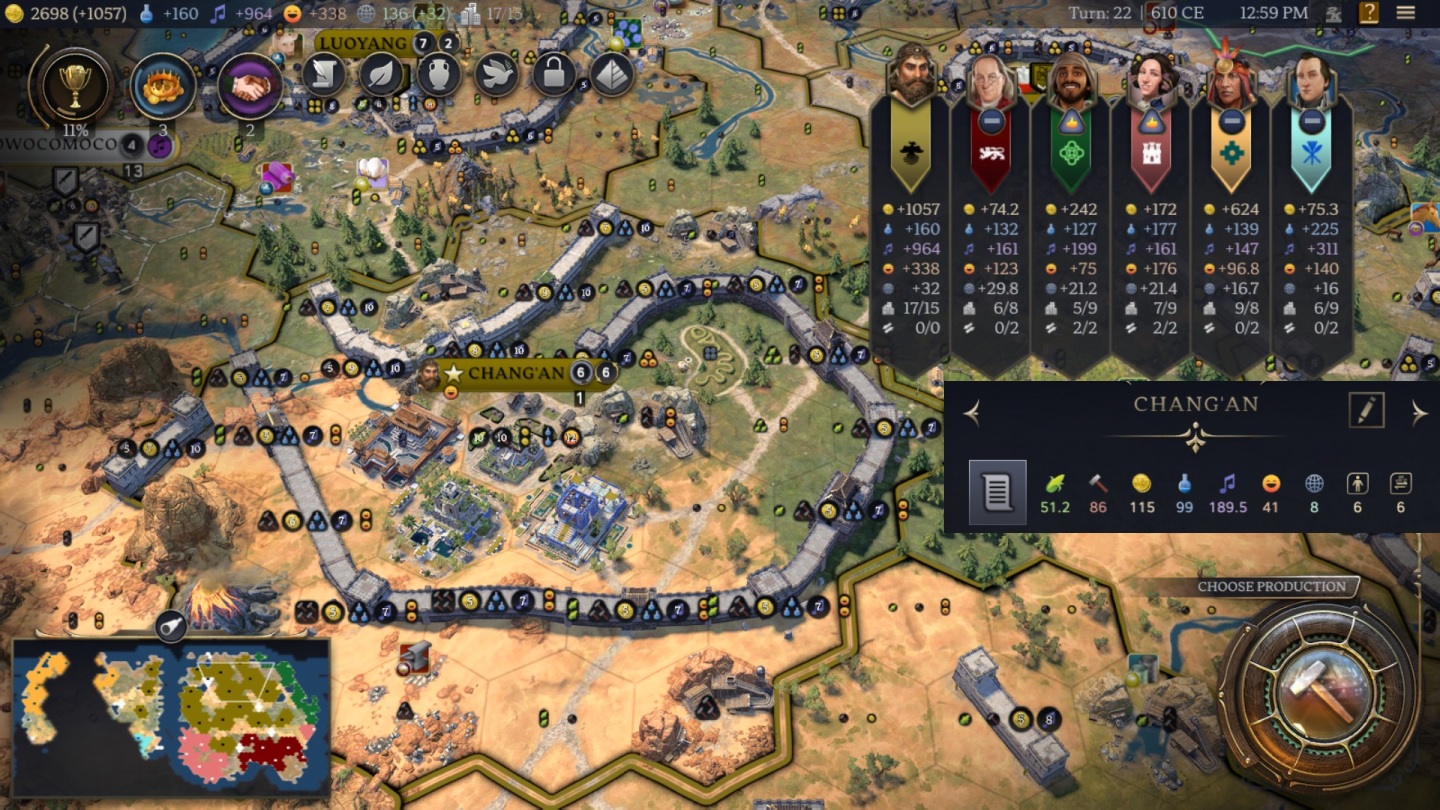
Two of the Exploration age wonders synergized really well with these variant rules. The first was the Serpent Mount which adds +2 production and +3 beakers to every unique improvement in the settlement. Then I paired that with the Forbidden City which added +2 gold and +2 culture on all fortification tiles in the settlement, with every Great Wall segment of both types qualifying as a form of fortification. The result was Great Wall segments with some truly insane tile yields, like the Ming Walls with 1 food / 3 production / 8 gold / 3 beakers / 10 culture for a total yield of 25. These numbers were starting to approach the total yield of 40 needed for the Science legacy scoring in this era though of course they couldn't be boosted any higher without the ability to assign specialists to rural tiles. Amusingly, Chang'an by itself was producing more culture than several of the entire civs of my AI competitors, if readers needed yet another indication of how incompetent they were.
The other wonder that I targeted was El Escorial which grants +1 settlement limit; it also has some extra happiness and relic slots that I didn't care about. This wonder completed a little bit later and the wonder plus a whole bunch of settlement increases in the civics tree looked like they would be sufficient to get me up to 20+ settlements. I also made sure to pick up the only increase to the settlement cap on the tech tree at Feudalism. Unusually though, I was more interested in the tech mastery aspect of Feudalism:
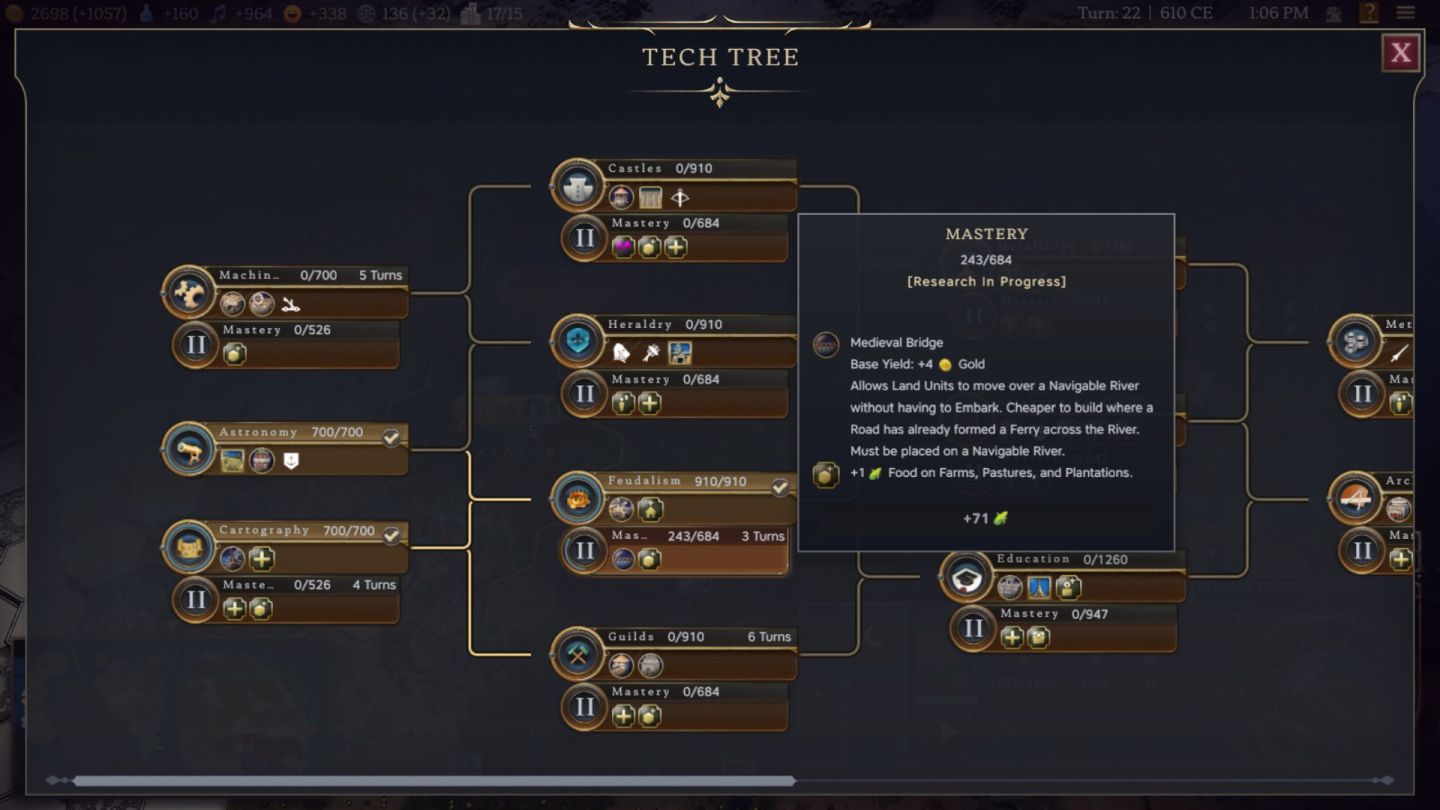
I mentioned this back in the first part of the report and it bears repeating: most of the science tree is associated with new buildings which were all forbidden under these restrictions. The other big thing on the tech tree is more advanced units which again served little purpose for the game that I was playing. Why would I want to go to war and struggle through the hordes of spammed AI defenders when I could simply settle open parts of the map instead? Therefore I was targeting a bunch of the tech masteries which boosted rural tile yields, like the Feudalism mastery that added extra food on farms, pastures, and plantations. Fortunately all of these masteries associated with rural tiles were located in the early parts of the tech tree which allowed me to get there with my limited research output. I can't say that I've ever taken a route through the tech tree that looked anything like this before.
My friendship with that Economic independent power from earlier came to fruition on Turn 28 and I picked the Company Post option. This is a unique tile improvement that I've used in several of my other games, letting the player add a Company Post worth a base 4 gold on top of a rural tile. The Company Post gains an additional 2 gold if there's a resource assigned to the settlement, plus a further 1 food and 1 production if it's located on the distant lands continent, plus another 3 gold and 3 culture in this game by virtue of my being Achaenemid Xerxes and having my memento choices. The one downside is that Company Posts can't be placed next to one another which limits the ability to spam them. Long story short, this was a whole lot of bonuses and I would later add lots of Company Posts in my towns once I ran out of room to place the Great Wall segments. I would eventually take the Stone Head unique tile improvement option (worth a base 4 culture) from one of the Cultural city states to have another option for places where I couldn't put multiple Company Posts together. Everything gets a unique improvement of some kind!

The Ming Great Walls were bugged in exactly the same fashion as the Han Great Walls from the previous era, dropping the population of the settlement in question whenever they were slotted into the building queue. The main difference in implementation was that I had far more money available to spend on them by this point, so instead of carefully picking and choosing where to add a wall segment as I had done in the early game, now I was instantly rush-buying a wall every time that a settlement grew a size, immediately removing the population that had just grown. This meant that my newest towns over on the distant lands continent were rapidly catching up to my older towns by virtue of working off microscopically small food boxes. In fact, the original towns couldn't ever drop below the size 3 food box because they had all started there by virtue of the Han extra population point ability. That Han unique ability was actually a bad thing here!
Ming China lacked that ability which allowed me to cap them all at the size 2 food box which was a mere 57 food thanks to having the Hanging Gardens. The town of Beiping was already making 46 food/turn thanks to running double Farmer's Market endeavors plus the food from its natural tile yields. In fact, these towns were growing faster and faster as their food from rural tiles kept going up while their food boxes remained the same size. Eventually I had a couple of towns that exceeded 57 food/turn and were quite literally growing every single turn onto a new wall segment. They would have grown endlessly without bound if they hadn't run out of places to put the wall segments eventually, after which I switched them over to Company Posts and Stone Heads which caused growth to finally slow down. Long story short: my new settlements on the distant lands continent grew very, very fast as a new round of Great Walls extended over the landscape.
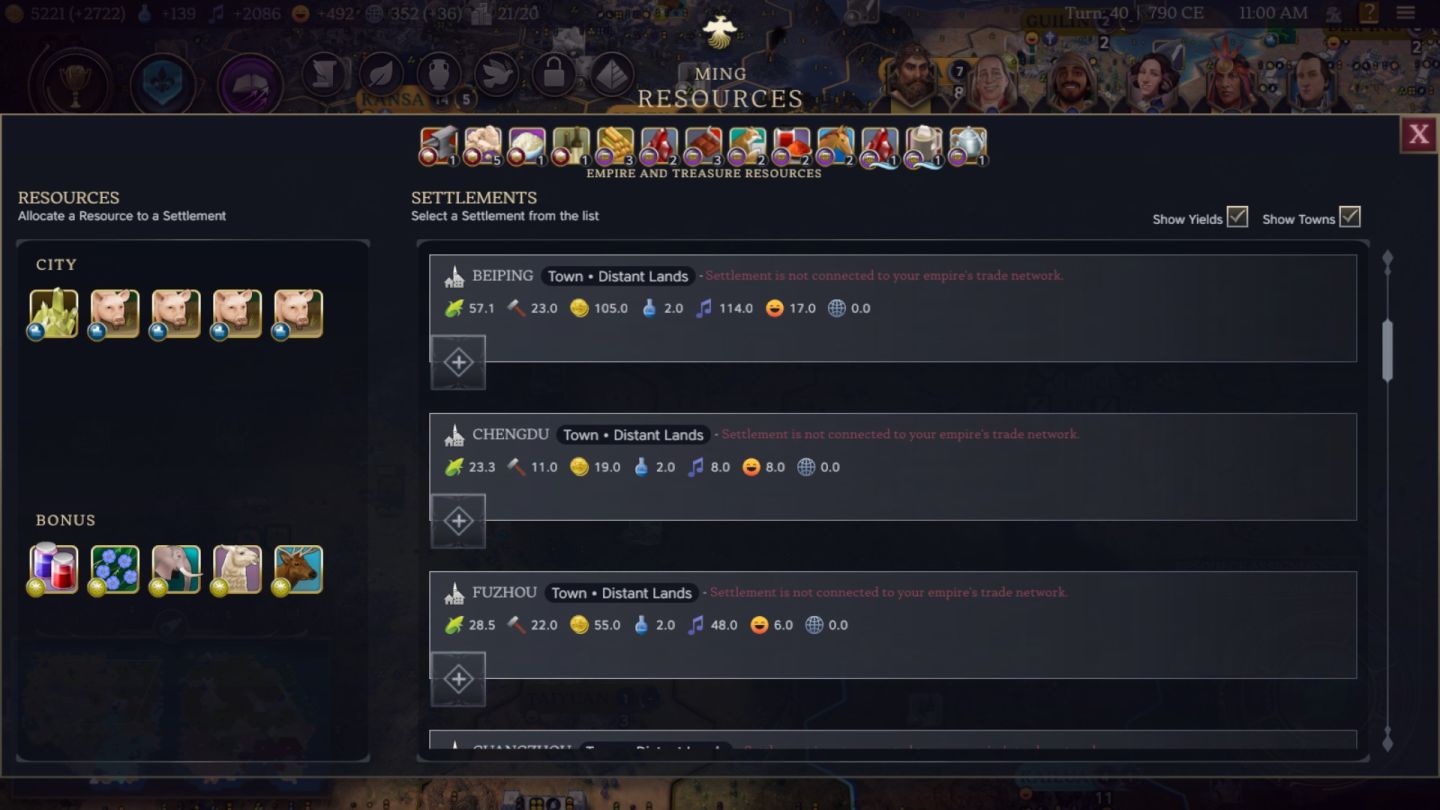
There was one drawback, however: none of those settlements could ever be connected back to the homelands. Resource connections require having a Fishing Quay or some other water-based building to pass across the ocean and that was something I would never own. All of these distant lands towns therefore couldn't make use of any of my resources aside from what happened to be present in their own local radius. It also meant that I would never generate any treasure fleets even though I controlled lots of the associated resources, locking me out of any scoring for the Economic category in this era. Oddly, the empire-wide global resources did continue to function despite lacking a trade connection; the Civ7 developers probably never thought anyone would play the game this way and simply added them to that bar at the top of the resource screen anyway. Despite this restriction, the new towns were still growing at an incredible rate and outputting huge amounts of gold and culture. Beiping was the oldest of the bunch and already making more than 100 per turn of both gold and culture barely 20 turns after its founding.

Here's where things stood after 40 turns of the new era. Beiping had *ALREADY* finished its entire 13-tile Great Wall and was now beginning to grow onto Company Posts, two of which are visible at the southwest corner of the town's borders. All of the other towns were growing at a furious pace while building their own Great Walls, including two more towns offscreen to the west and another two settlers still heading further afield. I had already reached the maximum settlement cap of 20 and had calculated that I could go up to 23 settlements while only suffering minimal unhappiness in a handful of towns. I could have technically gone even higher but thought any more than 23 settlements would be excessive for this age, especially with the AI empires struggling to reach even 10 settlements apiece. I have no idea why they don't expand faster given that everyone other than Pachacuti was under the settlement cap and everyone had tons of happiness to spare. Look at that minimap: there were VAST expanses of unclaimed territory on the distant lands continent even with me planting close to ten additional cities over there. The gameplay just becomes trivial when the player can out-expand the AI this badly on the highest difficulty.
I also wanted to highlight my civics research: I had completed the whole civics tree by this same Turn 40. That included researching all of the unique Ming civics along with the entire main civics tree, with nothing left to do except head into the Future Civic category. This civic grants a Wildcard attribute point that can be spent anywhere and advances the era by 10 points, equal to hitting one of the tier 2 scoring goals for the Exploration age. The first Future Civic cost about 4000 culture in this game and then each additional one kept increasing by that same amount, with the second one costing 8000 culture and the third one costing 12,000 culture etc. I wondered how many of these I'd be able to complete before the age finished since the era meter was only reading 25% and we were clearly nowhere close to the formal transition.
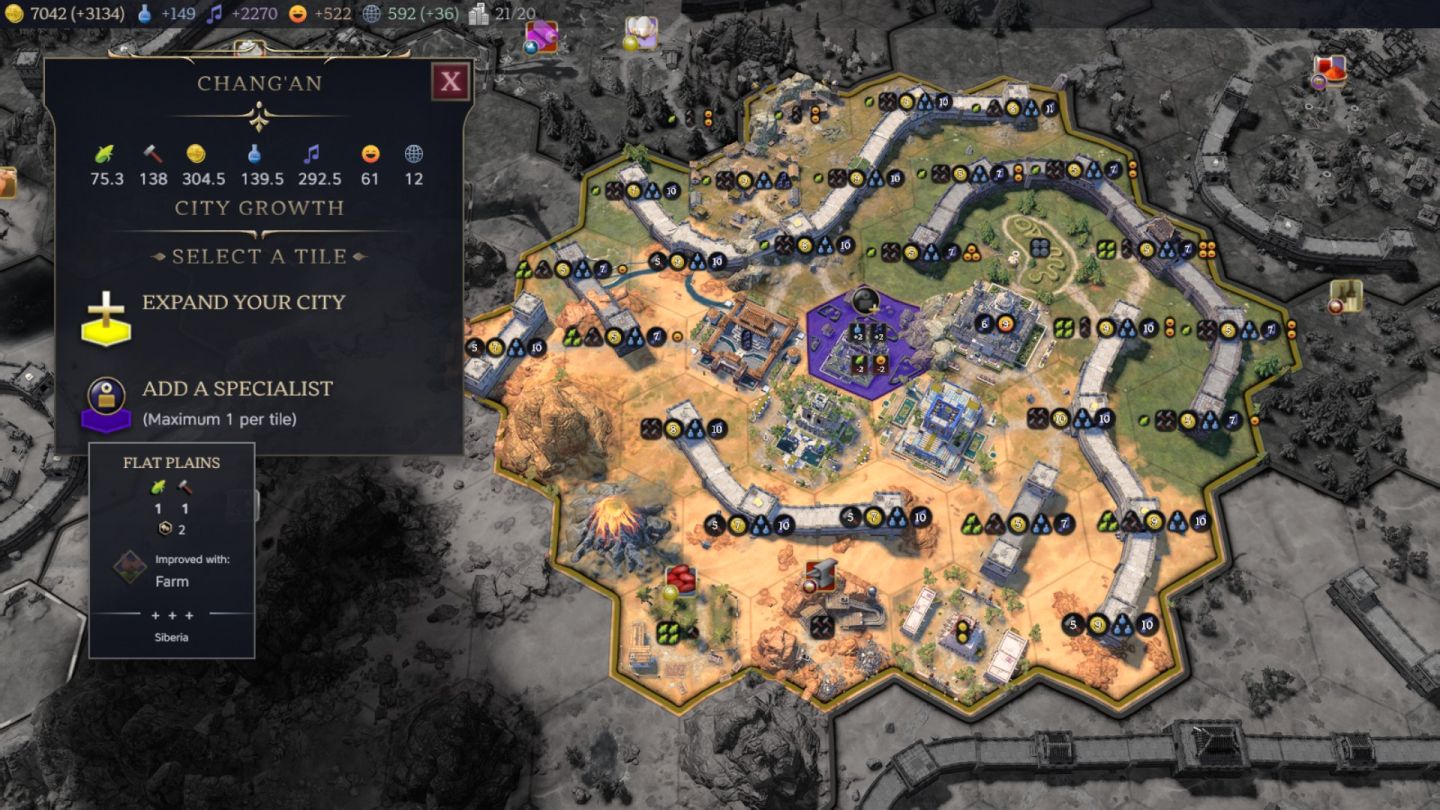
This was fun to experience: Chang'an eventually had a rural tile improvement or a wonder on every single tile. The only thing that I could do with this new population point was assign it as a specialist on the palace's tile, the only thing that qualified as an urban tile and therefore could host specialists. If you're wondering what happens when all of the specialist slots also filled up, Chang'an began generating migrants which could travel to any other settlement and add a population point. This is the kind of stuff that the player never gets to experience in a normal game and it's a major reason why I have fun running these wacky variant concepts. What a lovely city! (Even if the Serpent Mount looked suspiciously like a Dickbutt drawing.)
Then there was this bit of large-scale civic engineering:
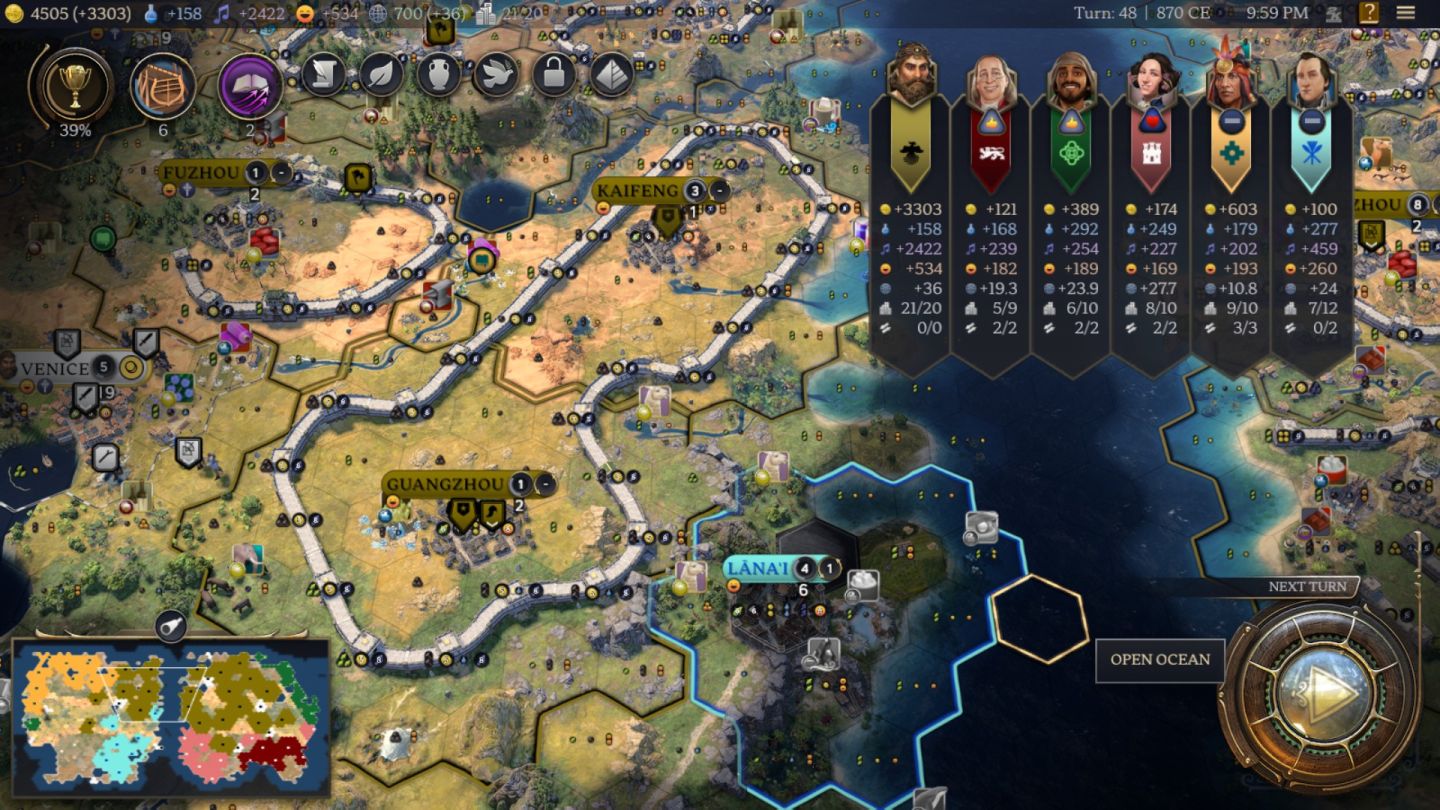
The towns of Kaifeng and Guangzhou built their Great Walls together into a single linked structure with 27 segments.  I didn't plan to do this ahead of time and only realized that they could connect together when the last few segments were being built. The whole thing looked really, really cool and I'm glad that I had the chance to create something like this; now if only Civ7 had the same free cammera mode present in Civ4 to zoom down for a closer inspection. If it wasn't obvious from what I've written thus far, I genuinely had a blast playing these turns up to around Turn 50. Watching my civ do its best cockroach impression across the map and replace barren wilderness with Great Walls everywhere happened to be deeply satisfying. I was essentially playing a sandbox game like Minecraft since the AI leaders were so far behind and didn't matter at all. The comparative yields at the corner of the screen were downright ghastly and getting worse and worse as time passed. I'd been having a lot of fun but the inability of the AI civs to put up a challenge was starting to get tiresome as the game went on.
I didn't plan to do this ahead of time and only realized that they could connect together when the last few segments were being built. The whole thing looked really, really cool and I'm glad that I had the chance to create something like this; now if only Civ7 had the same free cammera mode present in Civ4 to zoom down for a closer inspection. If it wasn't obvious from what I've written thus far, I genuinely had a blast playing these turns up to around Turn 50. Watching my civ do its best cockroach impression across the map and replace barren wilderness with Great Walls everywhere happened to be deeply satisfying. I was essentially playing a sandbox game like Minecraft since the AI leaders were so far behind and didn't matter at all. The comparative yields at the corner of the screen were downright ghastly and getting worse and worse as time passed. I'd been having a lot of fun but the inability of the AI civs to put up a challenge was starting to get tiresome as the game went on.
And unfortunately this problem only grew worse as turn after turn progressed. While the first 50 turns of the Exploration age had been highly entertaining, everything started to drag worse and worse as time passed. I had founded all of my settlements by now, and after having constructed something like 300 Great Wall segments, adding another half dozen of them every turns was getting less interesting. I would have founded more settlements but nope, can't do that, I was already well over the settlement cap and couldn't really go any higher. My gold income ballooned so high that I was increasingly unable to spend it each turn despite my best efforts. I fell back on cash-rushing extra army commanders and even with my purchase discounts the cost hit 5000 or 6000 gold per commander because I'd bought so many of them. I'd had my fun but now the gameplay had become stale and boring. This game was obviously over, what was the best way to achieve victory from here?
I had a plan for that, one that would have worked beautifully. However, this map once again ruined it with awful RNG luck:
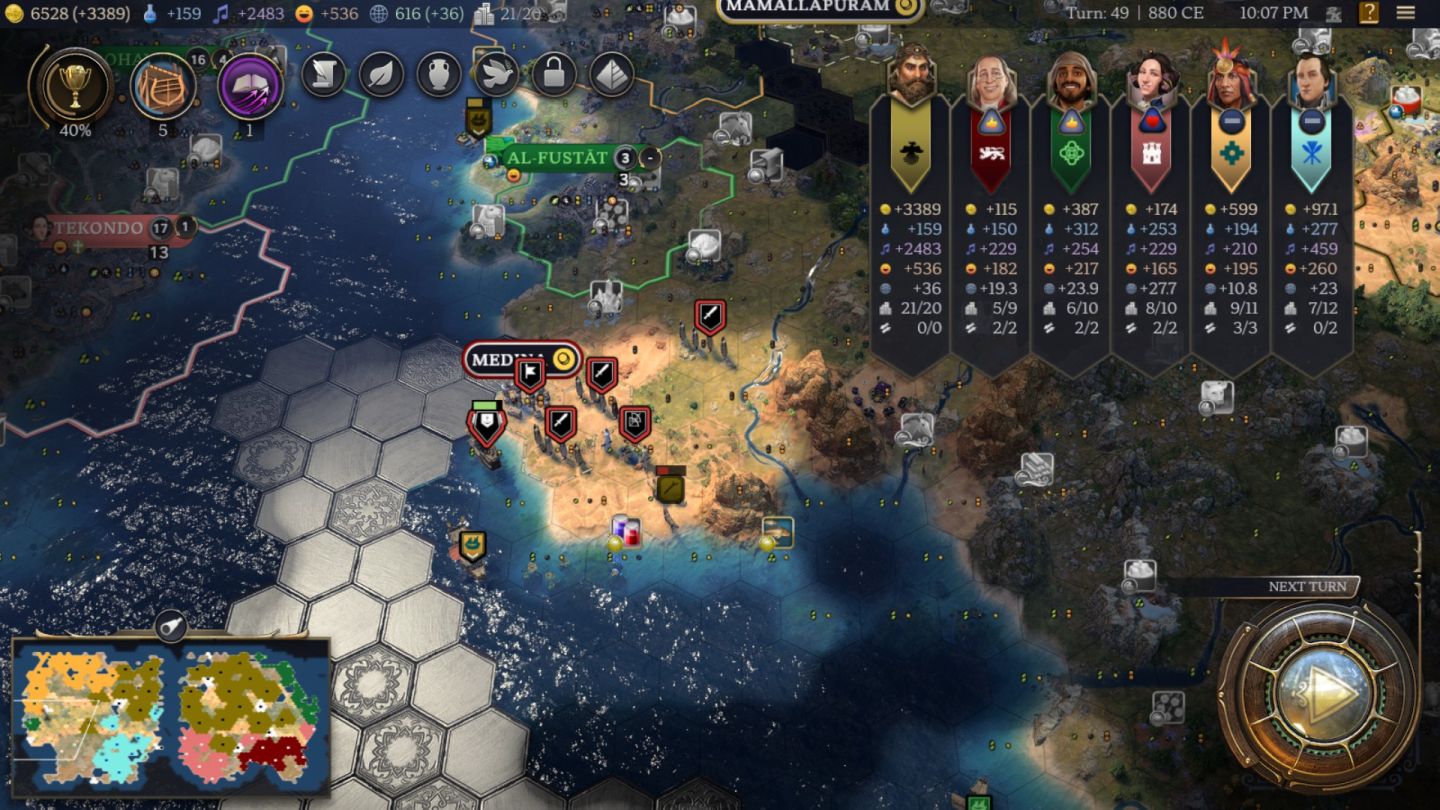
This was the final independent power that I uncovered on the map; everything had been defogged at this point other than the deep oceans. This IP was another Commercial one and that was a huge problem because THERE WERE ZERO SCIENTIFIC IPs ON THIS MAP.  Every single one rolled as Cultural, Economic, or Military despite there being 11 IPs in total across the two continents. I ran the math on that and the odds came out under 1% once again, a catastrophically unfortunate result for the strategy that I'd had in mind. All that I needed was a single Scientific city state alliance since that would unlock the Monastery unique tile improvement. Monasteries have a base yield of 4 beakers and their only restriction is that they can't be placed next to a district. That's a massive drawback which makes them almost useless in a normal game but it would be no impediment at all for my variant.
Every single one rolled as Cultural, Economic, or Military despite there being 11 IPs in total across the two continents. I ran the math on that and the odds came out under 1% once again, a catastrophically unfortunate result for the strategy that I'd had in mind. All that I needed was a single Scientific city state alliance since that would unlock the Monastery unique tile improvement. Monasteries have a base yield of 4 beakers and their only restriction is that they can't be placed next to a district. That's a massive drawback which makes them almost useless in a normal game but it would be no impediment at all for my variant.
Therefore the plan had been to save up roughly 80,000 gold and convert *EVERY* unique tile improvement over to monasteries at the conclusion of the Exploration age. Every Great Wall, every Company Post, every Stone Head would be torn down and replaced with a Monastery to gain those precious beakers. Since I estimated that I had somewhere in the range of 300-400 of these various unique tile improvements, that would convert into thousands of beakers which would fully survive the era transition by virtue of being ageless. Then it would be easy to race through the Modern era tech tree and launch the spaceship for a quick victory. I could even boost all of my town yields with this ability from the Expansionist attribute tree:
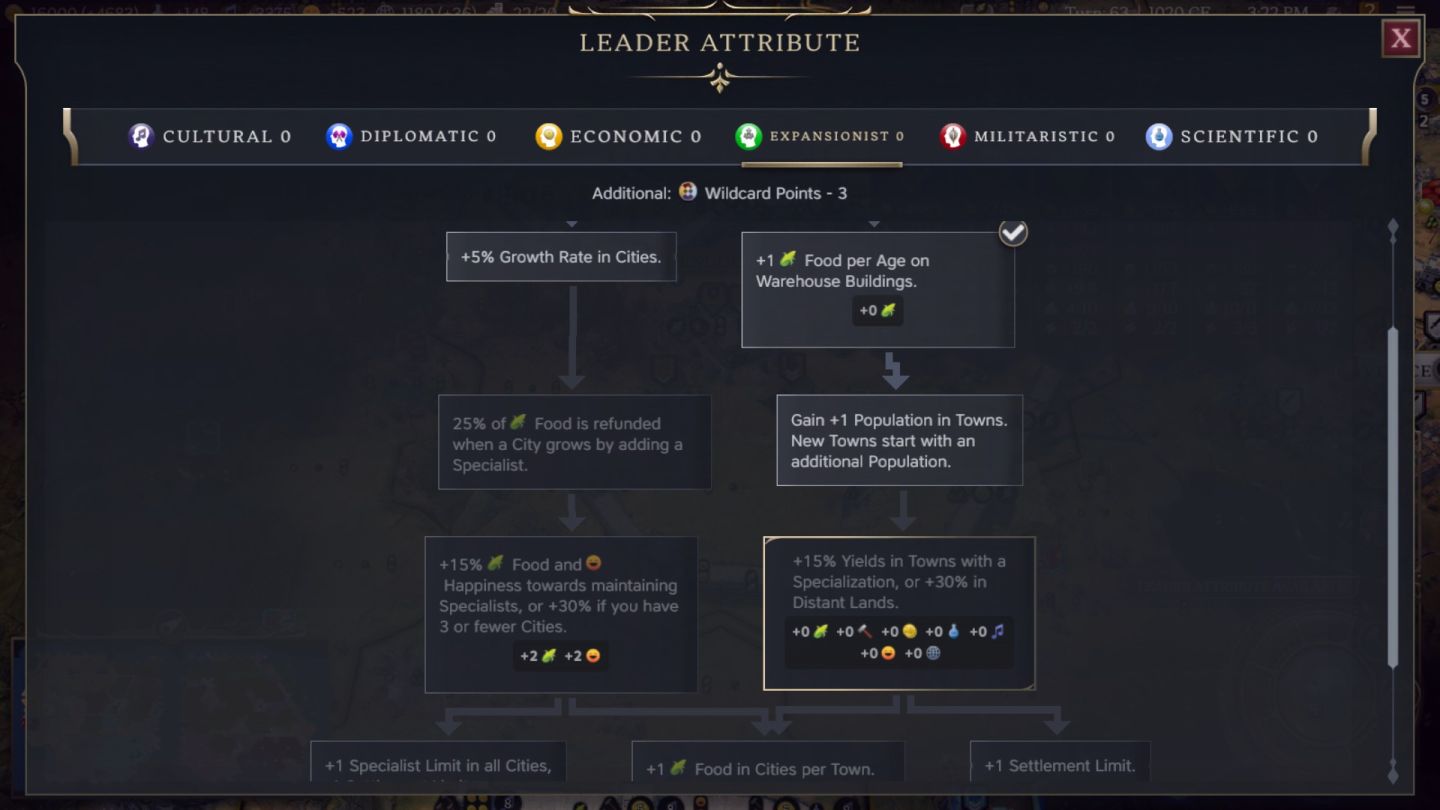
Researching multiple incarnations of Future Civic had given me plenty of extra attribute points to spend which I used for the +1 population in towns, another +1 settlement limit, and the town specialization ability that I most cared about in the middle. This granted +15% on ALL yields in towns with a specialization, increased to +30% for towns in the distant lands. None of my towns had a specialization at the moment since I wanted them on the growth option to keep getting bigger. Once the Modern era started though, I could convert everything over to a specialization option and pick up those huge increases to all yields. I'm confident that all of this would have translated into science yields as large or larger than my non-variant Himiko game thanks to having such an ungodly large amount of total population from Great Wall bug abuse.
But no Scientific IPs meant no Monasteries and therefore no opportunity to carry out this plan. There's a Scientific unique tile improvement in the Modern era, of course, but that one (the Institute) cannot be placed next to another Institute which would greatly limit how many I could place on the map. I also wouldn't be able to start adding them until after befriending a Scientific IP, something that would take 10-15 turns, and while there was a way around that by playing as Siam it wasn't the route that I wanted to take. The scientific path was simply going to be too slow if I didn't have access to Monasteries. Well, unfortunately my hand was forced here. I wanted to play a peaceful game and the map generation ruled it out. Since the Cultural and Economic victories were also off the table due to my inability to construct buildings, that meant it was going to have to be the Military option. I started cash-rushing units, lot and lots of units, aiming to carry as many of them over the era transition as possible.
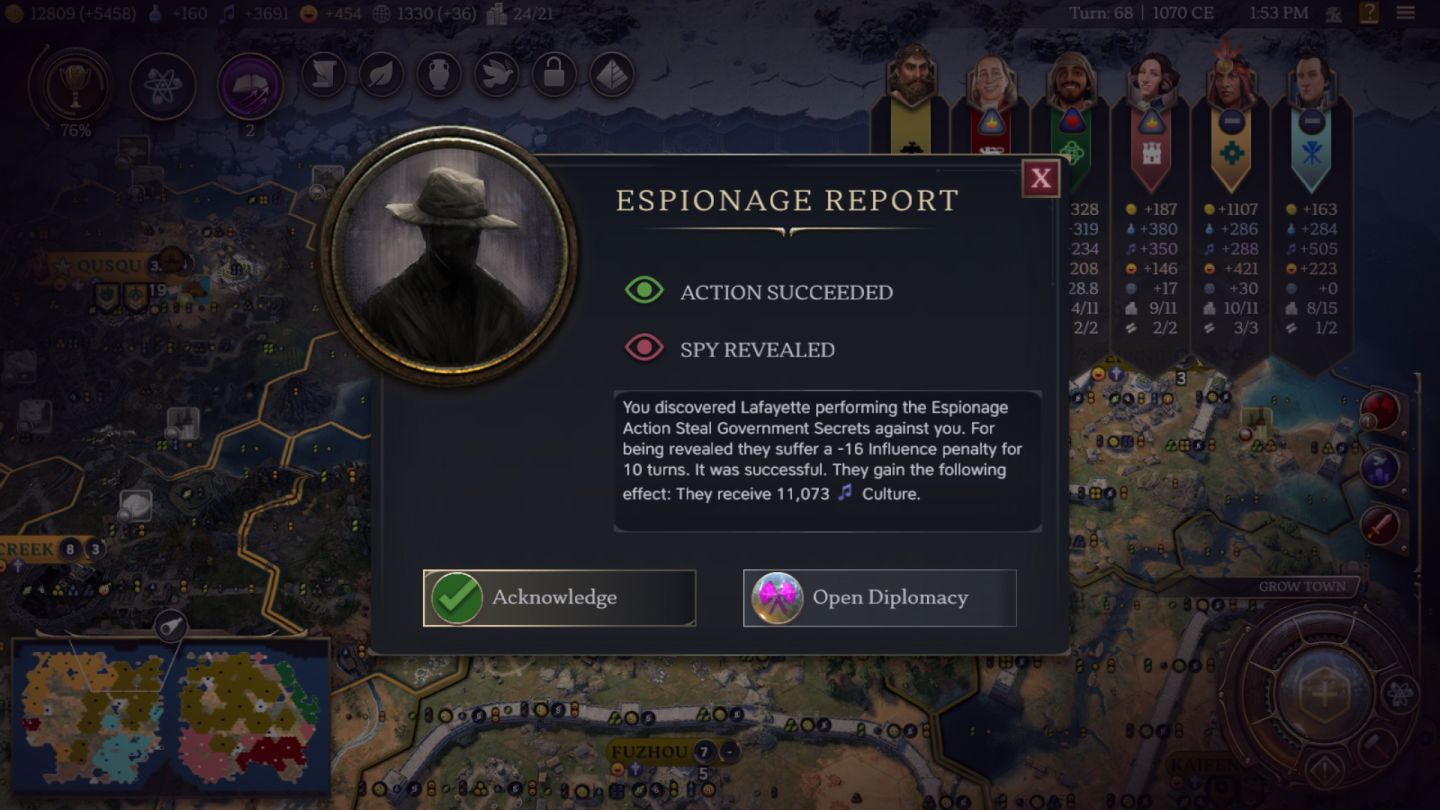
Thus the second half of the Exploration age turned into a dull click-fest with nothing of interest going on. My towns kept growing and I kept adding more unique tile improvements, I kept buying more and more military units, and my advantage over the AI empires on the comparative ribbons kept growing. This concept had been lots of fun but it had run its course, time to move onto something new. Unfortunately I remained stuck in the Exploration age because that stupid percentage counter in the corner of the screen barely moved. There was little I could do about it either: I had already achieved the few legacy scoring options permitted under my variant rules, and eventually I researched Future Civic no less than SEVEN times in succession, with the last one costing 29,000 culture to complete. And yet it was pointless using my immense military advantage against anyone else because anything that I captured wouldn't count towards the Military victory until the next era started. Nor could I convert my thousands and thousands of culture into more advanced civics because I was stuck in the Exploration age until everyone advanced simultaneously. Sheesh does this whole era system suuuuuuuuck in Civ7. How could so much money and developer time have been spent coming up with something as unfun as this?
The problem here was the AI civs. The era meter ticks up slowly over time but gets its biggest increases when someone achieves "era score" points by completing legacy scoring goals (or less commonly when an AI civ gets eliminated). The meter was moving more slowly than normal because I was unable to achieve any of the tier 3 scoring goals, each of which is worth 20 era score points in the Exploration age. I was compensating by researching all of those Future Civics for additional era score but the AI civs had to do their part and they were failing spectacularly. More on this in a minute but they were pathetically bad at achieving any of the four scoring categories and that was dragging things out in tedious fashion. The most entertaining thing that happened during these turns was Lafayette using espionage to steal 11,000 culture from me - heh. That would get him the entire civics tree, if it mattered, which it didn't.
I honestly had to force myself to play these turns because they were so boring and they dragged out over three or four real-world days, running through a dozen turns at a time before stopping. Then suddenly, with no warning, I clicked Next Turn and received the message that the Exploration age had ended at the start of Turn 81. Say what?! The era meter had been reading 92% at the end of Turn 80, then instantly the era was over before the next turn began. I've never seen that before: every other time that I've experienced an era transition, the player had one final turn at 100% before the age transitioned. Not even getting that final turn was absurd. Since I still had some final tweaks to make before the era ended, I reloaded back one turn to Turn 80. (What is with this game stealing control away from the player so many times?!  )
)

For sake of amusement, I converted every single town over to a specialization on this final turn of the Exploration age to take advantage of that new ability from the Exploration attribute tree. This swelled my final gold total to 8600 per turn which defies all reason and logic for the second era of the game. Culture similarly topped out at 4500 per turn which wasn't even worth comparing to the other AI empires in the game, they might as well have been hunter-gatherers stumbling upon the entrance to the Louvre. What was shocking to me again was that my science was right in the middle of the pack, despite having no science buildings or science-boosting tile improvements, and these AI dodos all having the various Deity bonuses. Seriously, what a bunch of idiots. Is this really the best that Firaxis can do?
I also had a lot of military by now - like, lots and lots of military. In fact, I think my income would have been over 9000 (heh) if not for the heavy troop maintenance that I was paying. Virtually every part of the territory that I controlled was now covered by Great Walls, with the original continent having two different sets of walls on display:

I thought that I would include at least one screenshot with the tile yields turned off to highlight the walls themselves as they snaked across the hills and valleys. What a beautiful sight!
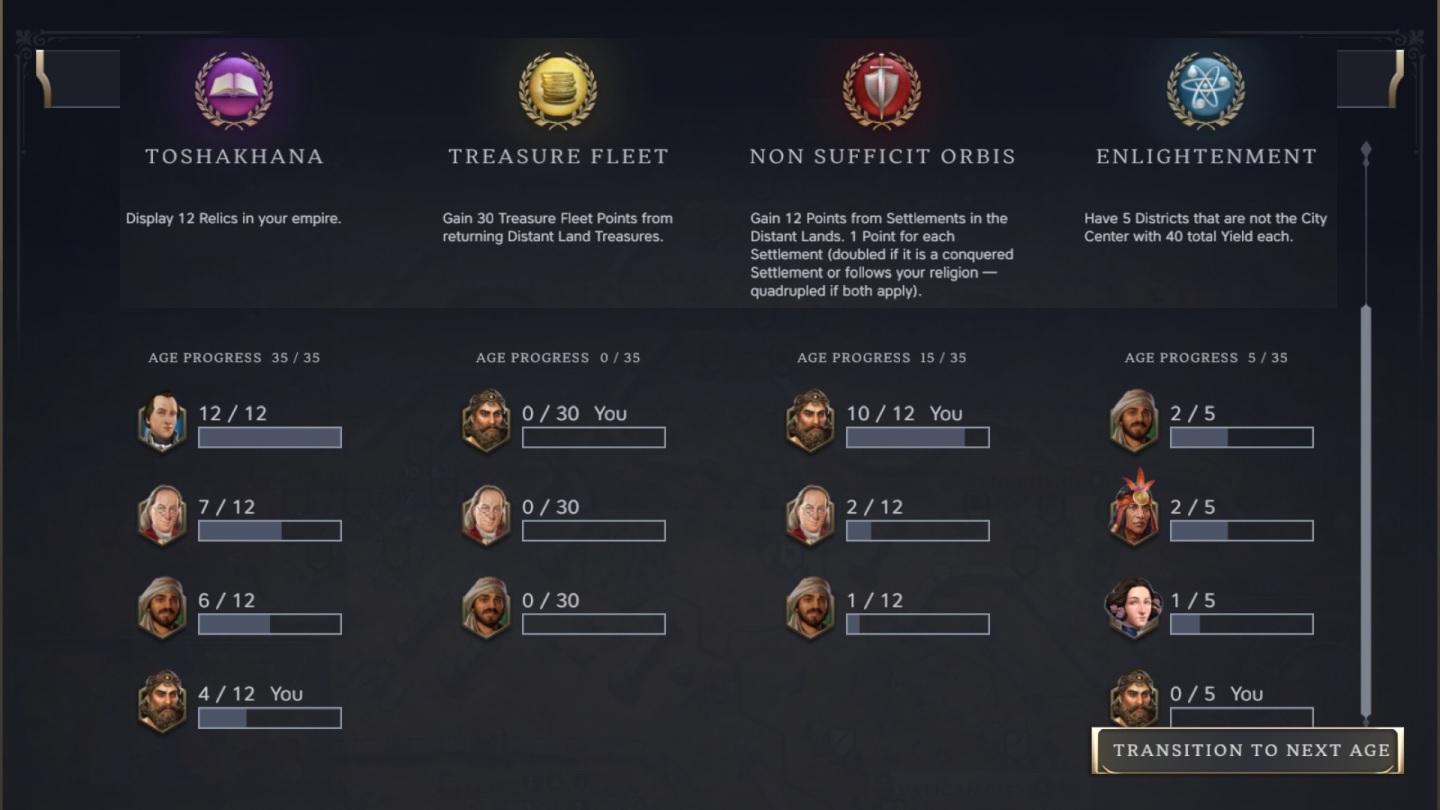
Once again, the era came to a close at the end of Turn 80 and before I could do anything on Turn 81. This advanced the gameplay to the final legacy scoring for the Exploration age which was appallingly bad for the AI civs. The Cultural scoring category was the only place where any of them had achieved the full tier 3 scoring; in fact, it was the only place that any of them even managed to achieve the tier 2 scoring goal! The AI leaders can run around the map with missionaries and collect relics but they sure can't do much of anything else. Three of them managed to get a few tiles to a total yield of 40, though Franklin and Lafayette couldn't manage even one such instance across their empires, and then Franklin and Ibn Battuta had a pittance in the Military category due to their pathetic expansion on the distant lands continent. Ada Lovelace had no settlements at all overseas, nor did Pachacuti or Lafayette since the home continent was already full. Then everyone was a complete failure in the Economic category, with none of them accumulating even a single treasure fleet resource over the course of the era. I was barred from competing in that category due to my variant but they had no such excuses.
This whole screen is a damning indictment of Civ7's core gameplay design. The legacy scoring goals were poorly chosen for the Exploration age and force the player into dull, repetitive gameplay that railroads them to an extent we've never seen before in past games. On top of that, the AI clearly has no idea how to achieve any of these goals aside from the "spam missionaries everywhere" category which also happens to be the least-satisfying of the group. The entire gameplay has been reconfigured into a minigame based around four scoring goals, only those scoring goals were poorly chosen, don't make sense for a Civilization game, and the player's competing opponents can't accomplish three of the four goals! What an utter disaster. 
In any case, even though I was unable to score any points in the Cultural, Economic, and Scientific categories by variant rule, somehow I still had more legacy scoring points than anyone other than Lafayette. The plan was to go crack some heads in the Modern era and then mercifully put this game to rest. Please let's just get this over with.



